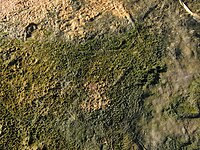
Photo from wikipedia
Aim Ecological communities that exist closer together in space are generally more compositionally similar than those far apart, as defined by the distance?decay of similarity relationship. However, recent research has… Click to show full abstract
Aim Ecological communities that exist closer together in space are generally more compositionally similar than those far apart, as defined by the distance?decay of similarity relationship. However, recent research has revealed substantial variability in the distance?decay relationships of microbial communities between studies of different taxonomic groups, ecosystems and spatial scales and between those using different molecular methodologies (e.g., high-throughput sequencing versus molecular fingerprinting). Here, we test how these factors influence the strength of microbial distance?decay relationships, in order to draw generalizations about how microbial ?-diversity scales with space. Location Global. Time period Studies published between 2005 and 2019 (inclusive). Major taxa studied Bacteria, Archaea and microbial Eukarya. Methods We conducted a meta-analysis of microbial distance?decay relationships, using the Mantel correlation coefficient as a measure of the strength of distance?decay relationships. Our final dataset consisted of 452 data points, varying in environmental/ecological context or methodological approaches, and we used linear models to test the effects of each variable. Results Both ecological and methodological factors had significant impacts on the strength of microbial distance?decay relationships. Specifically, the strength of these relationships varied between environments and habitats, with soils showing significantly weaker distance?decay relationships than other habitats, whereas increasing spatial extents had no effect. Methodological factors, such as sequencing depth, were positively related to the strength of distance?decay relationships, and choice of dissimilarity metric was also important, with phylogenetic metrics generally giving weaker distance?decay relationships than binary or abundance-based indices. Main conclusions We conclude that widely studied microbial biogeographical patterns, such as the distance?decay relationship, vary by ecological context but are primarily distorted by methodological choices. Consequently, we suggest that by linking methodological approaches appropriately to the ecological context of a study, we can progress towards generalizable biogeographical relationships in microbial ecology.
Journal Title: Global Ecology and Biogeography
Year Published: 2021
Link to full text (if available)
Share on Social Media: Sign Up to like & get
recommendations!